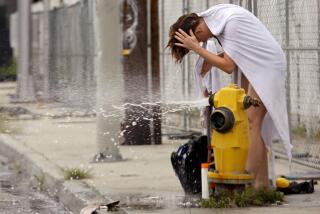Times Square’s Community Court Offers Full-Service Justice
- Share via
NEW YORK — Herbert J. Sturz and Gerald Schoenfeld had breakfast at Manhattan’s Hotel Pierre one morning in 1991 to discuss a serious problem plaguing the renovation of Times Square.
Schoenfeld, chairman of the Shubert Organization, and Sturz, a former deputy mayor for criminal justice administration, agreed such quality-of-life crimes as prostitution, shoplifting and drug dealing were creating a repellent atmosphere for tourists and developers.
“There was a sense that people were threatened by low-level offenses,” Sturz recalled. “I said if you turn over a theater, I’d try to put a court” in its place.
With support from city officials and a coalition of community groups, businesses, banks, foundations and educational institutions, the Midtown Community Court opened in October 1993.
It was the start of an experiment that has drawn praise from Atty. Gen. Janet Reno and law enforcement officials nationwide. Delegations from Japan, Switzerland, Russia, Australia and Israel have studied the court’s innovations.
“It is a unique model for the criminal justice system,” Mayor Rudolph W. Giuliani said of the court, which not only has contributed to the restoration of Times Square but has also become a template for a new generation of judicial attempts to respond to crime.
“I see the community court as a giant step forward in regaining public confidence,” said Judith Kaye, New York state’s chief judge.
It is the first criminal court in the country to situate programs dispensing health care, drug treatment, education and mandatory community service in its building. The decision grew out of the nature of the court’s calendar.
“These are not terribly complicated legal cases, but complicated because they were committed by people with complicated lives,” said John Feinblatt, director of the Center for Court Innovation, which oversees the court’s operation.
This comprehensive approach is grounded in fundamental philosophy: When a crime is committed, the community suffers.
“The neighborhood is the victim. The block is the victim. Our theory is they should be paid back for the cost of crime in a way that is meaningful to them,” Feinblatt said.
The community court, which handles misdemeanors occurring in the Times Square area and two nearby police precincts, is a reaction to New York’s centralized court system, in which felonies are stressed and low-level crimes often receive lesser priority.
The Midtown Community Court makes cases count by assigning the same judge for at least a year to allow continuity of justice. And committees of local residents meet regularly with the judge and the court’s staff to discuss problems and progress.
Justice is highly visible. Visitors entering the court in the converted theater on West 54th Street are greeted by a TV screen that displays the schedule of cases, complete with charges against all defendants.
*
Inside the courtroom, a research coordinator reviews computerized data--not just arrest records but issues of homelessness, health or drug problems, job skills and other facts to give the judge pertinent information and match defendants with drug treatment or community service programs.
Almost 80% of sentences include community service in the area where the crime occurred. Defendants remove graffiti, maintain tree pits and sort and stuff mail free for local nonprofit groups.
Cooperating with local businesses, the court also operates Times Square Ink, a full-service copy center, providing job skills to former offenders who have completed community service.
Four days a week, a team of police and court workers search neighborhood streets for drug addicts, the homeless or people likely to commit crimes. Often, the team convinces them to visit the courthouse voluntarily for counseling, drug treatment and other services.
More to Read
The biggest entertainment stories
Get our big stories about Hollywood, film, television, music, arts, culture and more right in your inbox as soon as they publish.
You may occasionally receive promotional content from the Los Angeles Times.










